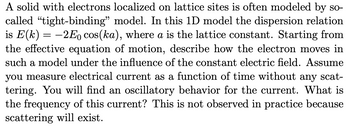Question

Transcribed Image Text:A solid with electrons localized on lattice sites is often modeled by so-
called "tight-binding" model. In this 1D model the dispersion relation
is E(k)= -2Eo cos(ka), where a is the lattice constant. Starting from
the effective equation of motion, describe how the electron moves in
such a model under the influence of the constant electric field. Assume
you measure electrical current as a function of time without any scat-
tering. You will find an oscillatory behavior for the current. What is
the frequency of this current? This is not observed in practice because
scattering will exist.
Expert Solution
This question has been solved!
Explore an expertly crafted, step-by-step solution for a thorough understanding of key concepts.
Step by stepSolved in 3 steps with 15 images
